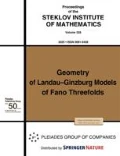Abstract
It is well known that every control that steers the trajectory of a control system to the boundary of the reachable set satisfies the Pontryagin maximum principle. This fact is valid for systems with pointwise constraints on the control. We consider a system with quadratic integral constraints on the control. The system is nonlinear in the state variables and linear in the control. It is shown that any admissible control that steers the system to the boundary of its reachable set is a local solution of some optimal control problem with quadratic integral functional if the corresponding linearized system is completely controllable. The proof of this fact is based on the Graves theorem on covering mappings. This implies the maximum principle for the controls that steer the trajectories to the boundary of the reachable set. We also discuss an algorithm for constructing the reachable set based on the maximum principle.
Similar content being viewed by others
References
N. N. Krasovskii, Theory of Motion Control (Nauka, Moscow, 1968) [in Russian].
A. B. Kurzhanskii, Control and Observation under Uncertainty (Nauka, Moscow, 1977) [in Russian].
A. I. Subbotin and V. N. Ushakov, “Alternative for an encounter–evasion differential game with integral constraints on the players’ controls,” J. Appl. Math. Mech. 39 (3), 367–375 (1976).
V. I. Ukhobotov, “On a class of differential games with an integral constraint,” J. Appl. Math. Mech. 41 (5), 838–844 (1977).
V. N. Ushakov, “Extremal strategies in differential games with integral constraints,” J. Appl. Math. Mech. 36 (1), 12–19 (1972).
B. T. Polyak, “Convexity of the reachable set of nonlinear systems under L2 bounded controls,” Dyn. Contin. Discrete Impuls. Syst., Ser. A: Math. Anal. 11, 255–267 (2004).
N. Huseyin and A. Huseyin, “Compactness of the set of trajectories of the controllable system described by an affine integral equation,” Appl. Math. Comput. 219, 8416–8424 (2013). doi 10.1016/j.amc.2013.03.005
Kh. G. Guseinov and A. S. Nazlipinar, “Attainable sets of the control system with limited resources,” Trudy Inst. Mat. Mekh. UrO RAN 16 (5), 261–268 (2010).
K. G. Guseinov, O. Ozer, E. Akyar, and V. N. Ushakov, “The approximation of reachable sets of control systems with integral constraint on controls,” Nonlinear Diff. Equat. Appl. NoDEA 14 (1–2), 57–73 (2007). doi 10.1007/s00030-006-4036-6
A. B. Kurzhanskii and I. Ya. Pishchulina, “Minimax filtering in the case of quadratic constraints. I–III,” Differents. Uravn. 12 (8), 1434–1446; 12 (9), 1568–1579; 12 (12), 2149–2158 (1976).
B. I. Anan’ev, “Correction of motion under communication constraints,” Autom. Remote Control 71 (3), 367–378 (2010).
M. I. Gusev, “On optimal control problem for the bundle of trajectories of uncertain system,” in Large-Scale Scientific Computing (Springer, Berlin, 2010), Ser. Lecture Notes in Computer Sciences 5910, pp. 286–293. doi 10.1007/978-3-642-12535-5 33
N. N. Subbotina, E. A. Kolpakova, T. B. Tokmantsev, and L. G. Shagalova, The Method of Characteristics for Hamilton–Jacobi–Bellman Equations (Izd. UrO RAN, Yekaterinburg, 2013) [in Russian].
E. B. Lee and L. Markus, Foundations of Optimal Control Theory (Wiley, New York, 1967; Nauka, Moscow, 1972).
F. P. Vasil’ev, Optimization Methods (Faktorial, Moscow, 2002) [in Russian].
A. D. Ioffe, “Metric regularity and subdifferential calculus,” Russ. Math. Surv. 55 (3), 501–558 (2000).
E. Beckenbach and R. Bellman, An Introduction to Inequalities (New York, Random House, 1961; Mir, Moscow, 1965).
A. V. Arutyunov, G. G. Magaril-Il’yaev, and V. M. Tikhomirov, Pontryagin Maximum Principle: Proofs and Applications (Faktorial, Moscow, 2006) [in Russian].
E. J. Cockayne and G. W. C. Hall, “Plane motion of a particle subject to curvature constraints,” SIAM J. Control 13 (1), 197–220 (1975). doi 10.1137/0313012
V. S. Patsko, S. G. Pyatko, and A. A. Fedotov, “Three-dimensional reachability set for a nonlinear control system,” J. Comput. Syst. Sci. Int. 42 (3), 320–328 (2003).
M. I. Gusev and I. V. Zykov, “A numerical method for solving linear–quadratic control problems with constraints,” Ural Math. J. 2 (2), 108–116 (2016). doi 10.15826/umj.2016.2.009
Author information
Authors and Affiliations
Corresponding author
Additional information
Original Russian Text © M.I.Gusev, I.V. Zykov, 2017, published in Trudy Instituta Matematiki i Mekhaniki UrO RAN, 2017, Vol. 23, No. 1, pp. 103–115.
Rights and permissions
About this article
Cite this article
Gusev, M.I., Zykov, I.V. On Extremal Properties of the Boundary Points of Reachable Sets for Control Systems with Integral Constraints. Proc. Steklov Inst. Math. 300 (Suppl 1), 114–125 (2018). https://doi.org/10.1134/S0081543818020116
Received:
Published:
Issue Date:
DOI: https://doi.org/10.1134/S0081543818020116


